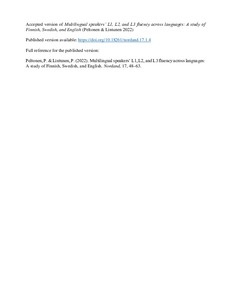Multilingual speakers’ L1, L2, and L3 fluency across languages: A study of Finnish, Swedish, and English
Lintunen Pekka; Peltonen Pauliina
https://urn.fi/URN:NBN:fi-fe2022081155053
Tiivistelmä
The present study provides a multilingual perspective on speech fluency by examining fluency across first language (L1), second language (L2), and third language (L3) productions in Finnish, Swedish, and English among L1 Finnish (Group 1, G1) and Finnish–Swedish bilingual (Group 2, G2) university students in Finland. The two research questions focused on differences in speech fluency across the three languages between the groups and correlations across speech fluency measures in the different languages. Ninety speech samples in Finnish (L1), Swedish (L1/L3), and English (L2) from 30 participants were analyzed in the present study. The speech samples consist of short picture narrations based on comic strip prompts. The fluency analyses focused on temporal fluency and stalling mechanisms. The data were analyzed quantitatively with Mann-Whitney U-tests and Spearman’s rank-order correlation coefficients. The results demonstrated minor differences between the groups in their Finnish (L1) and English (L2) productions, but a higher level of fluency in Swedish for G2 (their L1) than G1 (their L3). For G1, the correlations were strongest between their L1 Finnish and L2 English, whereas for G2, mostly moderate to strong correlations were found between the different language pairs. The results suggest connections in fluency across the languages in a multilingual speaker’s repertoire, but the strength of the correlations varies depending on the participants’ L1(s) and proficiency level in the additional languages. Based on the findings, further research on fluency among multilingual speakers is needed. The results have implications for L2 teaching and assessment.
Kokoelmat
- Rinnakkaistallenteet [19207]
